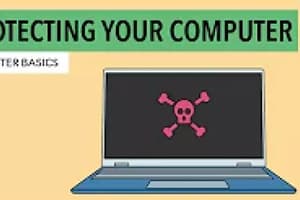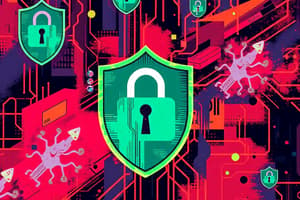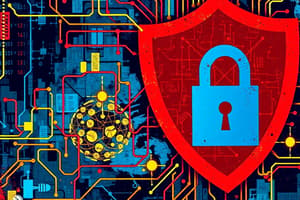Podcast
Questions and Answers
What is the main purpose of malware?
What is the main purpose of malware?
- To provide free software to users
- To enhance computer performance
- To generate revenue for cybercriminals (correct)
- To improve network security
Which type of malware is disguised as legitimate software?
Which type of malware is disguised as legitimate software?
- Ransomware
- Viruses
- Worms
- Trojans (correct)
How can malware like viruses affect a computer system?
How can malware like viruses affect a computer system?
- By encrypting user data
- By speeding up the system performance
- By replicating and modifying files (correct)
- By improving network security
Which behavior on a device could indicate the presence of malware?
Which behavior on a device could indicate the presence of malware?
What does spyware do once it collects information?
What does spyware do once it collects information?
How is ransomware different from other types of malware?
How is ransomware different from other types of malware?
What is the main characteristic of adware?
What is the main characteristic of adware?
How can malware infiltrate a computer system?
How can malware infiltrate a computer system?
Which of the following is a recommended practice to prevent malware infections?
Which of the following is a recommended practice to prevent malware infections?
What should you do if you suspect malware on your device?
What should you do if you suspect malware on your device?
Why is it important to update and reinstall affected software if a malware infection is suspected?
Why is it important to update and reinstall affected software if a malware infection is suspected?
Which security measure can help minimize data loss in case of a malware infection?
Which security measure can help minimize data loss in case of a malware infection?
Flashcards are hidden until you start studying
Study Notes
Understanding Malware
Malware, short for malicious software, is a broad term encompassing various forms of harmful programs created by cybercriminals to exploit computer systems, networks, and users. These threats aim to steal sensitive data, cause damage, or generate revenue for their creators. Malware includes viruses, worms, trojans, spyware, ransomware, and more, each with its unique characteristics and infection methods.
Identifying Malware
Malware can manifest through unusual behavior on devices, such as:
- Slowing down, crashing, or displaying repeated error messages
- Unwanted pop-ups, ads, or toolbars
- Changing homepage settings or redirecting browser activity
- Enabling new default search engines or creating new tabs or websites
Types of Malware
- Viruses: Self-replicating programs that attach themselves to other files or programs. Once activated, a virus can delete, corrupt, or modify files.
- Worms: Malware that propagates by exploiting network vulnerabilities, replicating itself across systems and consuming computing resources.
- Trojans: Disguised as legitimate software, trojans gain access to your system and can steal data or install more malware.
- Spyware: Software that secretly collects information about a user or their computer's activity, which is then transmitted to a third party.
- Ransomware: Malware that locks a user out of their system, encrypting their data and demanding a ransom payment to unlock it.
- Adware: Software that displays unwanted advertisements and collects data on a user's computer usage, potentially slowing down their system or containing malicious components.
How Malware Infiltrates Systems
Malware can enter your computer system through various means, including:
- Downloading files from untrustworthy sources like suspicious emails, peer-to-peer file-sharing sites, or malicious websites
- Clicking on phishing emails or links that lead to malware downloads
- Visiting compromised websites or clicking on infected ads
- Opening email attachments from unknown or suspicious sources
Preventing and Removing Malware
To protect yourself from malware, follow these best practices:
- Download software and updates only from reputable sources
- Keep operating systems, antivirus software, and web browsers up-to-date
- Scan your device for malware regularly
- Install reputable antivirus software and keep it updated
- Avoid clicking on unknown or suspicious links, attachments, or ads
- Exercise caution when downloading software or files
- Use firewalls, intrusion detection systems, and other security measures
If you suspect malware on your device, take the following steps:
- Disconnect from the internet and avoid using your device for sensitive tasks
- Run a reputable antivirus program
- Update and reinstall any affected software
- Change your passwords for all accounts
- Back up your data regularly to minimize data loss in case of an infection
In conclusion, malware poses a significant threat to computer systems and user privacy. Staying informed and adopting appropriate security measures can help protect against malicious software and the damage it may cause.
Studying That Suits You
Use AI to generate personalized quizzes and flashcards to suit your learning preferences.




